The Intel Haswell Refresh Review: Core i7-4790, i5-4690 and i3-4360 Tested
by Ian Cutress on May 11, 2014 3:01 AM ESTCPU Synthetic Benchmarks
Content Creation - Cinebench
Based on MAXON’s CINEMA 4D animation software, Cinebench is used to determine the CPU and graphics performance via OpenGL. The software has gone through many iterations over the years, and here we use versions 10, 11.5 and 15 to compare single-threaded and multi-threaded CPU performance. As the generations increase, the software becomes more multithread aware and scales better, however for consistency with older results we keep the version 10 results in our database.
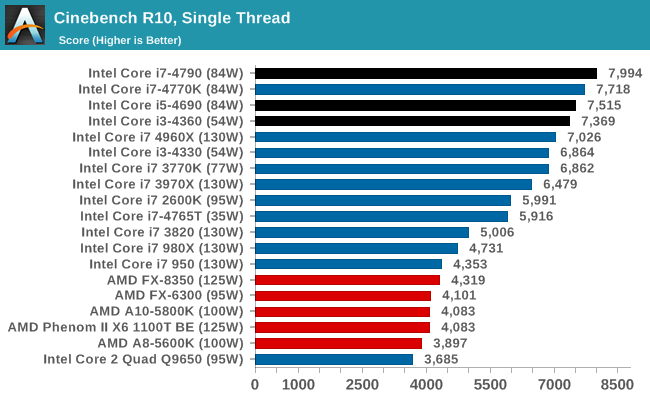

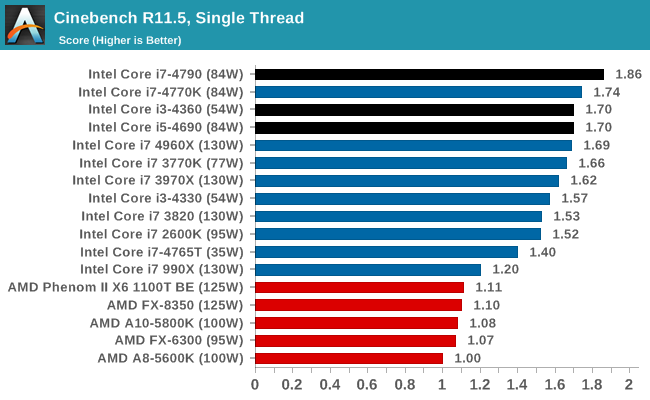
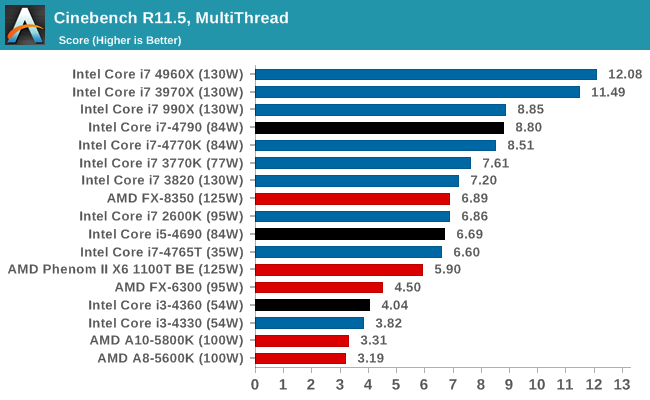

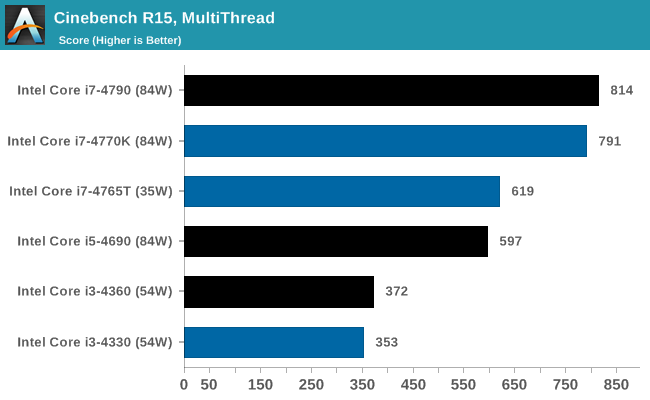
Video Conversion - x264 HD 3.03 Benchmark
Graysky's x264 HD test uses x264 to encode a 4Mbps 720p MPEG-2 source. The focus here is on quality rather than speed, thus the benchmark uses a 2-pass encode and reports the average frame rate in each pass.
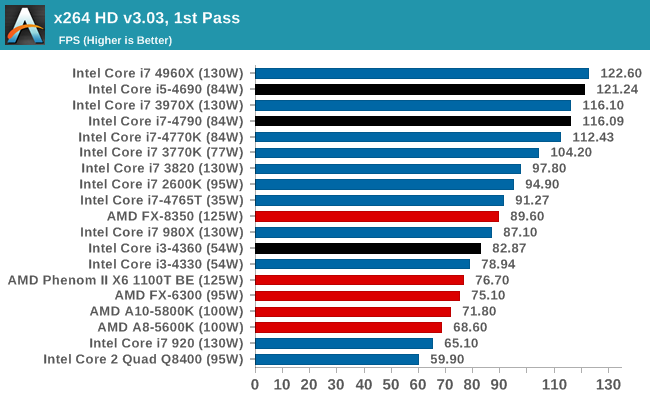

Encryption –TrueCrypt v0.7.1a: link
TrueCrypt is an off the shelf open source encryption tool for files and folders. For our test we run the benchmark mode using a 1GB buffer and take the mean result from AES encryption.
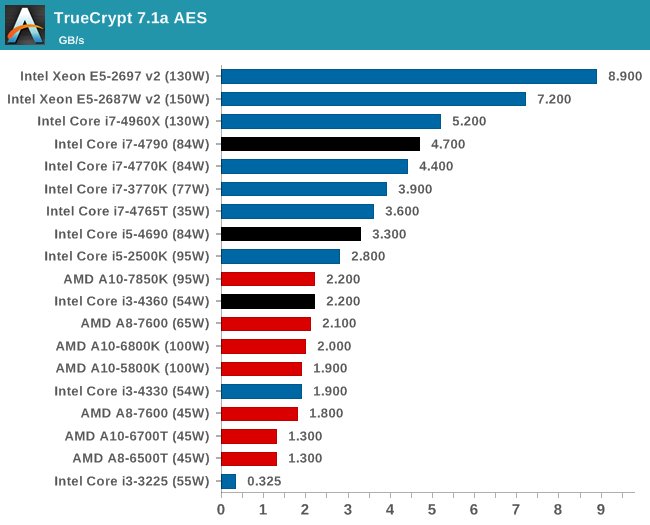
Synthetic – 7-Zip 9.2: link
As an open source compression tool, 7-Zip is a popular tool for making sets of files easier to handle and transfer. The software offers up its own benchmark, to which we report the result.
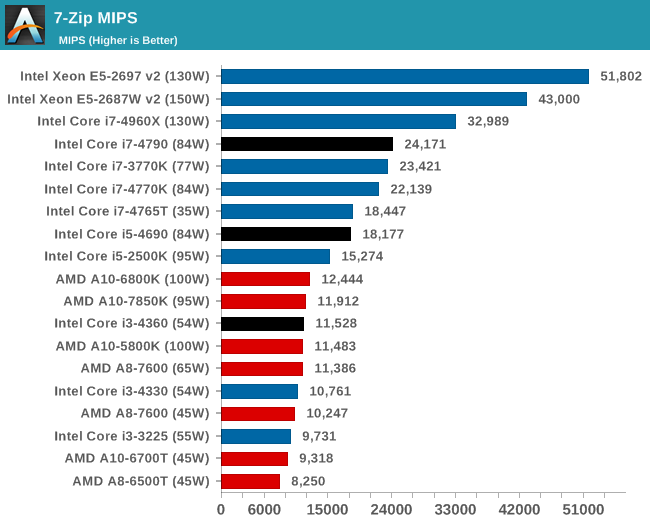
Rendering – PovRay 3.7: link
The Persistence of Vision RayTracer, or PovRay, is a freeware package for as the name suggests, ray tracing. It is a pure renderer, rather than modeling software, but the latest beta version contains a handy benchmark for stressing all processing threads on a platform. We have been using this test in motherboard reviews to test memory stability at various CPU speeds to good effect – if it passes the test, the IMC in the CPU is stable for a given CPU speed. As a CPU test, it runs for approximately 2-3 minutes on high end platforms.
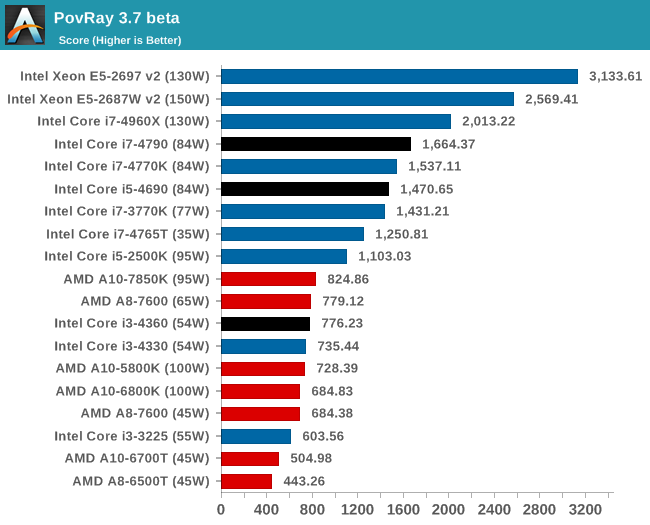
Console Emulation –Dolphin Benchmark: link
At the start of 2014 I was emailed with a link to a new emulation benchmark based on the Dolphin Emulator. The issue with emulators tends to be two-fold: game licensing and raw CPU power required for the emulation. As a result, many emulators are often bound by single thread CPU performance, and general reports tended to suggest that Haswell provided a significant post to emulator performance. This benchmark runs a Wii program that raytraces a complex 3D scene inside the Dolphin Wii emulator. Performance on this benchmark is a good proxy of the speed of Dolphin CPU emulation, which is an intensive single core task using most aspects of a CPU. Results are given in minutes, where the Wii itself scores 17.53; meaning that anything above this is faster than an actual Wii for processing Wii code, albeit emulated.
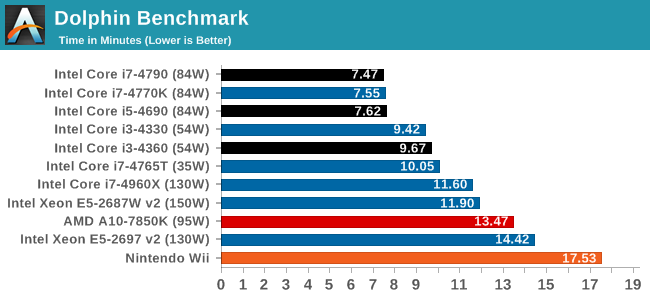
Dolphin relies very much on architecture as well as CPU single thread speed. It would also stand to reason that there is a small about of thread switching going on, given how far off the i3 and i7-4765T CPUs are.










130 Comments
View All Comments
Basilisk - Sunday, May 11, 2014 - link
While I enjoy the image of you chatting away with worms a'dangling, The Bard has his due:"Shall I bend low and in a bondman's key, With BATED breath and whispering humbleness, Say this..." [Shylock]. Billy originated the phrase, and his spelling is still considered correct... although it's a common enough error. Think of it as abated (restrained) breathing.
Informative article, however, so Thanks!
dwbogardus - Monday, May 12, 2014 - link
Really? I thought it meant breath that smelled like bait! (just kidding)coburn_c - Sunday, May 11, 2014 - link
I swear I saw a 'Death of the Desktop' and a 'PC gamers outnumber next-gen consoles' article in the same news feed last week.dave_the_nerd - Sunday, May 11, 2014 - link
So this is what you were working on?!?!10 days with no updates; you had me worried AnandTech. Thanks for the kickbutt review, as always.
davegraham - Sunday, May 11, 2014 - link
lol. in your conclusion, you say "baited breath" which would lead someone to believe that you smell of fish. what you meant to say is "bated breath" which approximates to your intent. :) great article overall Ian.IndyJaws - Monday, May 12, 2014 - link
Merchant of Venice +1FreeMan4096 - Sunday, May 11, 2014 - link
Impressive article. Bookmarking the webpage.Galatian - Sunday, May 11, 2014 - link
Ian: on page 12 dual 7970 testing in Bioshock Infinite the graph for minimum frame rates has the core i3 twice with two completely different values.Thanks anyway for the great article!
extide - Sunday, May 11, 2014 - link
"Eventually as the future of the chipset progresses, I see all these ports becoming flexible, though I would imagine we are a few years out from this." -- I actually don't think that will happen. It undoubtedly will increase the complexity of the chipset to allow the possibility for every single port to be configurable, thus increase costs. However, it is very unlikely that you would have a situation where you wouldn't want any SATA ports, or USB3 ports. Thus it seems pretty pointless to make ALL of the ports configurable. I would imagine that we will see a future with MORE configurability, but I would bet you will always see some dedicated ports.mapesdhs - Sunday, May 11, 2014 - link
If anyone's curious as to how the article's results compare to an oc'd older CPU,
here are some CB R15 numbers for a 5GHz i7 2700K (RAM @ 2133 CL10, ASUS M4E):
1-thread: 177
N-thread: 880
There's a power consumption difference of course, but the lower purchase cost of
a used 2700K makes up for it by more than an order of magnitude.
Ian.